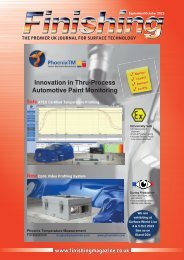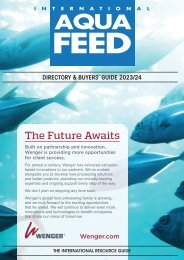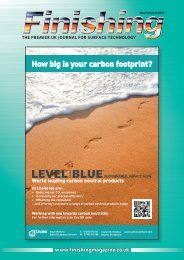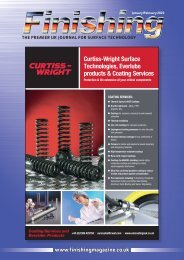Finishing - July-August 2022
This issue has the winners of the galvanizing industry awards, plus an update on the new Carlisle innovation centre. There is also a report from the BCF conference and a review of the Qualicoat conference with took place in London a few weeks ago. It’s great to see that in person events are taking place and that people are excited to go. Long may this continue!
This issue has the winners of the galvanizing industry awards, plus an update on the new Carlisle innovation centre. There is also a report from the BCF conference and a review of the Qualicoat conference with took place in London a few weeks ago. It’s great to see that in person events are taking place and that people are excited to go. Long may this continue!
Create successful ePaper yourself
Turn your PDF publications into a flip-book with our unique Google optimized e-Paper software.
36 LIQUID METALS<br />
Going with the flow<br />
Some metals are in liquid form, the prime<br />
example being mercury. But there are also<br />
enormous quantities of liquid metal in the<br />
Earth’s core, where temperatures are so high that<br />
part of the iron is molten and undergoes<br />
complex flows. A team at the Helmholtz-<br />
Zentrum Dresden-Rossendorf (HZDR) has now<br />
simulated a similar process in the laboratory and<br />
made a surprising discovery: Under certain<br />
circumstances, the flow of liquid metal is far<br />
more turbulent than expected – and this has a<br />
significant impact on heat transport, presents the<br />
group in the journal Physical Review Letters<br />
(DOI: 10.1103/PhysRevLett.128.164501). The<br />
editors found this new finding so remarkable<br />
that they highlighted the article as “Editor's<br />
Suggestion”.<br />
Temperatures deep inside the Earth are so<br />
high that part of its iron core is liquid. This liquid<br />
iron is in constant motion, continuously churning<br />
and circulating. It acts like a dynamo, causing our<br />
planet’s magnetic field to be generated. One<br />
driving force for this complex flow behaviour of<br />
iron is the Earth’s rotation, another is what is<br />
referred to as “convection”, driven by<br />
temperature differences: Similar to the way warm<br />
air rises above a radiator, where it displaces<br />
cooler air, relatively hot iron in the Earth’s core<br />
flows to cooler areas, resulting in heat transfer. As<br />
yet, however, little is known about how these<br />
processes take place in detail. To better<br />
understand them, experts have to rely on<br />
theoretical calculations and computer simulations,<br />
as well as experiments that simulate what is<br />
happening – at least to some extent – on a<br />
laboratory scale.<br />
One such experiment was conducted recently<br />
at the HZDR’s Institute of Fluid Dynamics. “We<br />
took two cylindrical vessels – a relatively small<br />
one about the size of a bucket and the other<br />
one shaped like a barrel with a volume of 60<br />
litres,” explained project leader Dr. Tobias Vogt.<br />
“We filled these vessels with a metallic alloy of<br />
indium, gallium and tin, which is liquid at room<br />
temperature.” The experts heated the bottom of<br />
the vessels whilst cooling the top, creating a<br />
temperature difference of up to 50 degrees<br />
Celsius between the higher and lower layers.<br />
Ultrasound provides in-depth<br />
view<br />
This substantial temperature difference caused<br />
the liquid metal inside the vessels to churn:<br />
Driven by convection, locally warmer flow areas<br />
such as columns rose and mixed with the cooler<br />
parts – similar to a lava lamp. Since the metal<br />
alloy used by the team is opaque, however, they<br />
had to resort to a special analytical technique: “It<br />
is an ultrasound method used in medicine,”<br />
explained Dr. Sven Eckert, Head of Department<br />
Magnetohydrodynamics at the HZDR. “We fitted<br />
around 20 ultrasonic sensors to the vessels,<br />
enabling us to detect how liquid metal flows<br />
inside them.”<br />
When analyzing the data, the research group<br />
made a surprising discovery. During the<br />
experiments, the experts had expected to find<br />
the clustering of individual flow areas to form a<br />
greater, more extensive structure, known as<br />
large-scale circulation. “This is comparable to a<br />
thermal wind, which is able to transport heat<br />
very effectively between the top and the<br />
bottom,” reported Vogt. “We were indeed able<br />
to observe this thermal wind in the smaller vessel<br />
– but with the larger vessel, the barrel, large<br />
temperature differences led to an almost<br />
complete breakdown of the wind.” This meant<br />
that heat was not transported as effectively as<br />
would have been expected. “We believe the<br />
cause of this to be the formation of much<br />
smaller-scale turbulence rather than a few large<br />
swirls, which makes heat transport less effective”,<br />
stated Vogt.<br />
Implications for battery<br />
technology<br />
These new findings could have implications<br />
for what happens in the Earth’s core: “To<br />
understand what is happening, experts are<br />
attempting to extrapolate the results of<br />
laboratory experiments to the scale of the Earth,”<br />
explained Sven Eckert. “But we have now shown<br />
that heat is transported less effectively under<br />
certain conditions than previous experiments had<br />
suggested.” This means that predictions for the<br />
Earth will likely also produce different values.<br />
“However, the real-life processes in the Earth’s<br />
core are many times more complex than in our<br />
laboratory experiments,” Tobias Vogt added. “For<br />
example, the flow of liquid iron is also influenced<br />
by the Earth’s magnetic field and rotation –<br />
ultimately, we know very little about these flow<br />
processes.”<br />
In fact, the new findings could also prove<br />
relevant for technology, especially in areas<br />
involving liquid metals. For example, liquid<br />
metals are used in some types of batteries as<br />
well as for future solar power plants, and the<br />
cooling of fusion reactors. To be able to take an<br />
even closer look at heat transport in liquid<br />
metals, the HZDR team are currently working<br />
on an advanced analytical technique. “Special<br />
induction sensors are expected to record flows in<br />
even greater detail than before and produce<br />
true 3D images,” remarked Sven Eckert. “Our<br />
initial measurements are very promising.”<br />
<strong>Finishing</strong> - <strong>July</strong>/<strong>August</strong> <strong>2022</strong>


















